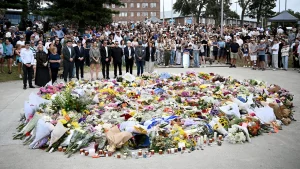Hurricane Makes Landfall in Jamaica
A powerful storm system made landfall in Jamaica on Tuesday afternoon, bringing with it torrential rains and powerful winds that caused widespread flooding and destruction across the island. Local authorities immediately activated emergency response teams as residents in coastal areas were forced to evacuate to higher ground. The storm’s intensity caught some communities by surprise, despite advance warnings from meteorological services.
The flooding was particularly severe in low-lying areas, where homes were submerged and roads became impassable. Many families lost everything as the raging waters swept through neighborhoods with frightening speed. “It happened so quickly,” said Maria Johnson, a resident of Kingston. “One minute we were preparing, the next our street was a river.” Emergency shelters quickly filled with displaced residents, while rescue teams worked tirelessly, often wading through chest-high water to reach stranded individuals.
Infrastructure damage has been extensive, with numerous bridges washed away and power lines down across the island. Telecommunications have been severely disrupted, making it difficult for many to contact loved ones or call for assistance. The island’s main power company reported that over 60% of customers were without electricity by Tuesday evening, and restoration efforts could take days or even weeks in the hardest-hit regions. Tourism, a critical part of Jamaica’s economy, has also suffered a significant blow as resorts along the coast experienced substantial damage to their facilities.
The Jamaican government has declared a state of emergency and is coordinating with international aid organizations to provide immediate relief. Prime Minister Andrew Holness addressed the nation late Tuesday, urging calm and resilience while promising that “no community will be left behind in our recovery efforts.” Local hospitals are operating on emergency generators as medical staff work around the clock to treat those injured during the storm. The international airport in Kingston has suspended all operations until further notice, further complicating relief efforts.
Community spirit has emerged as a bright spot amid the devastation, with neighbors helping neighbors and volunteers organizing impromptu rescue operations. Local churches and schools not affected by flooding have opened their doors to provide temporary shelter. “We may have lost our possessions, but we haven’t lost our humanity,” remarked Pastor Thomas Williams as he coordinated distribution of emergency supplies at his church in Montego Bay. Social media has become an important tool for coordination, with residents using platforms to share information about dangerous areas and locations where help is needed.
Meteorologists warn that the danger is not yet over, as saturated ground increases the risk of landslides in the island’s mountainous regions. Additional rainfall, even if lighter than during the main storm, could trigger further disasters. Environmental experts have pointed to the increasing intensity of Caribbean storms in recent years, linking the pattern to climate change. As Jamaica begins the long process of rebuilding, questions are being raised about how to better prepare for future weather events of this magnitude, with calls for improved early warning systems and more resilient infrastructure.











